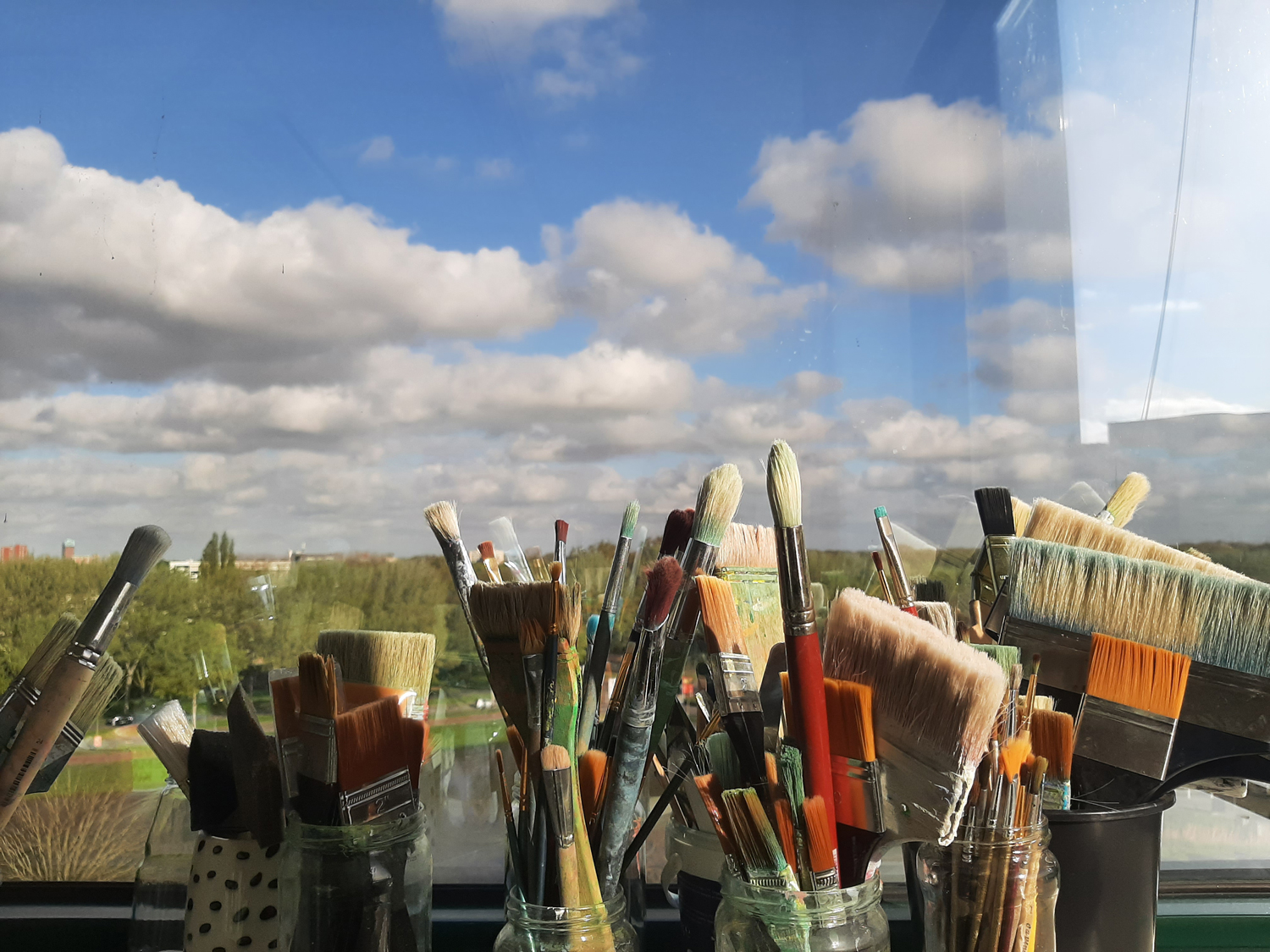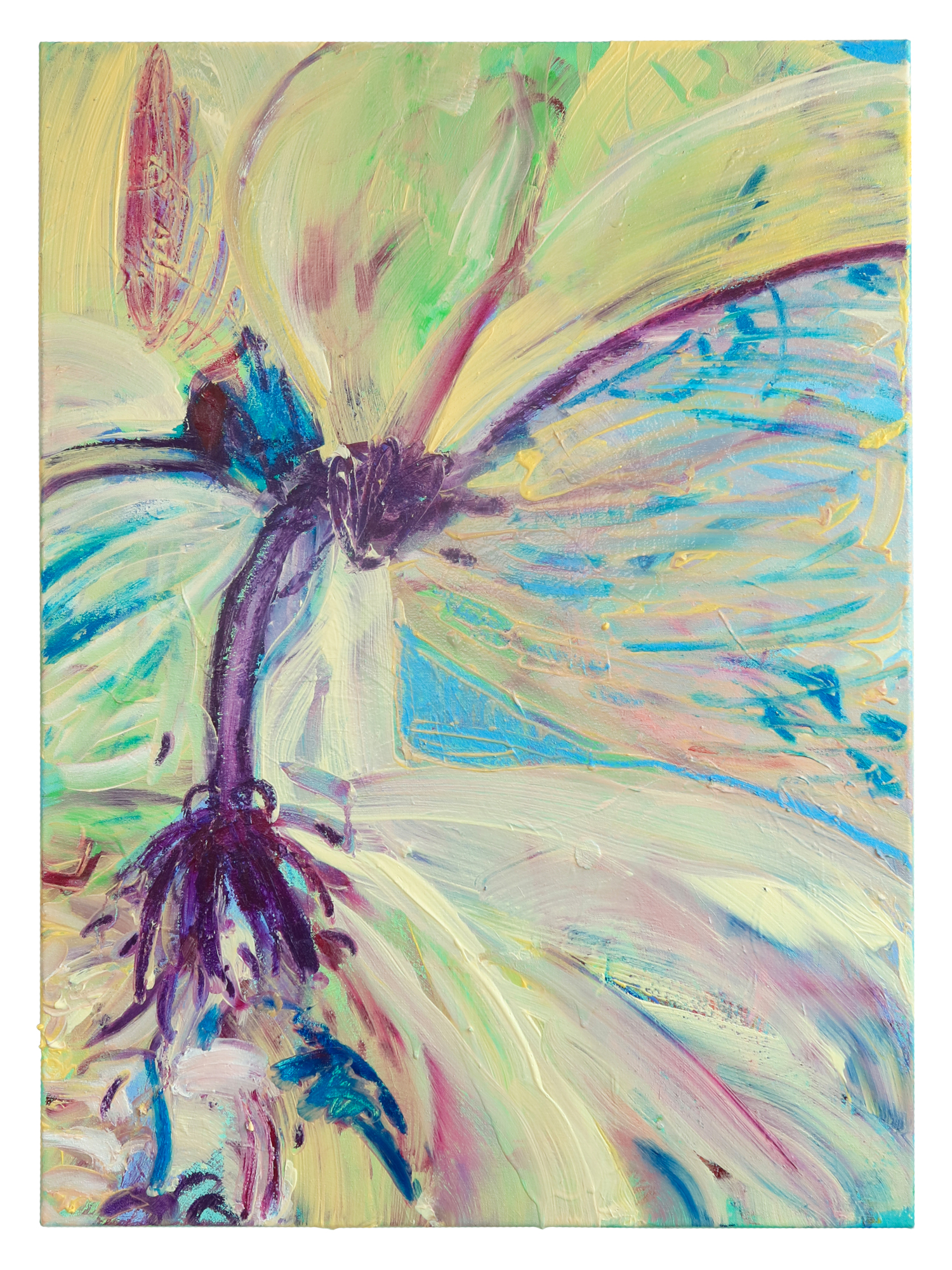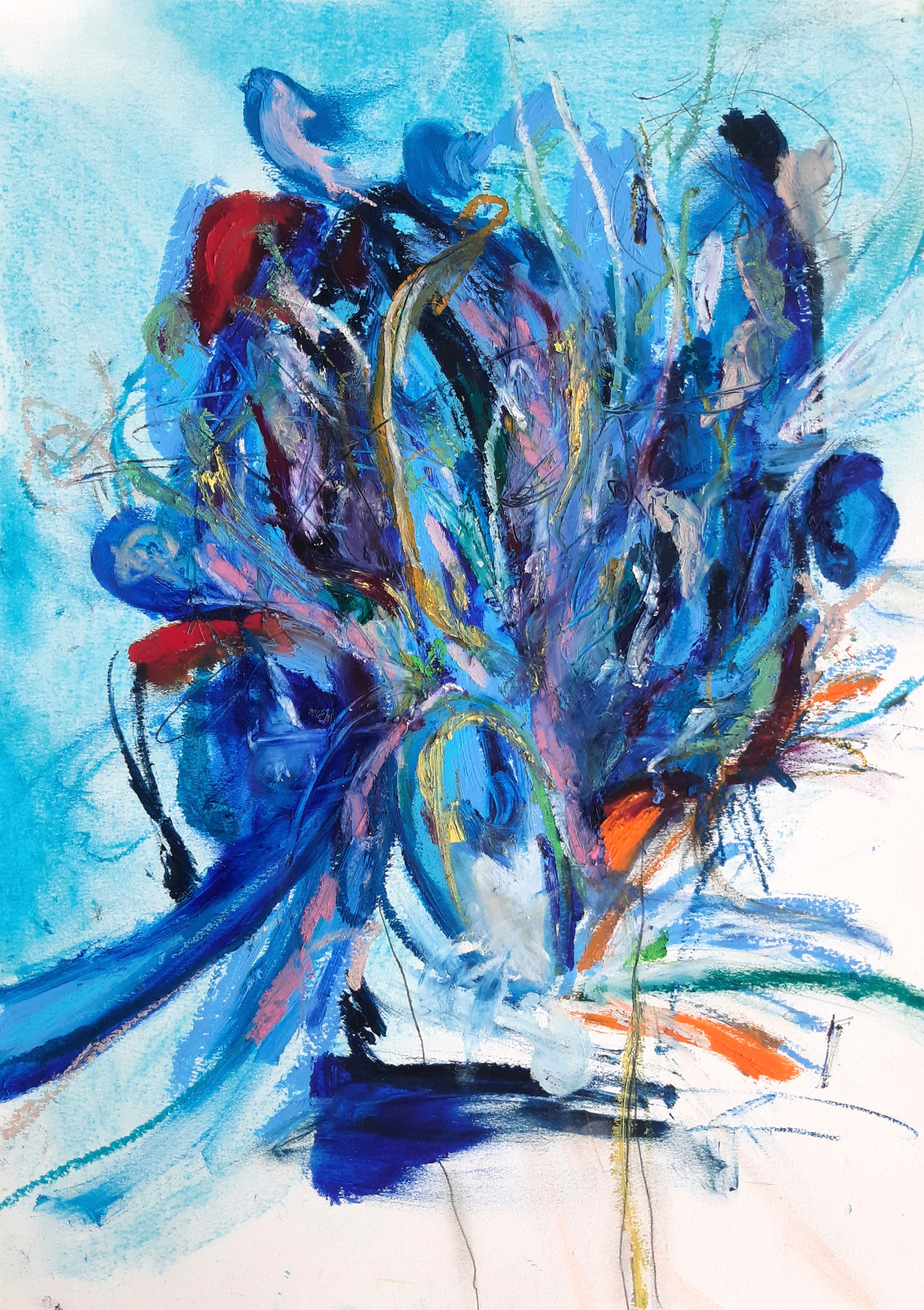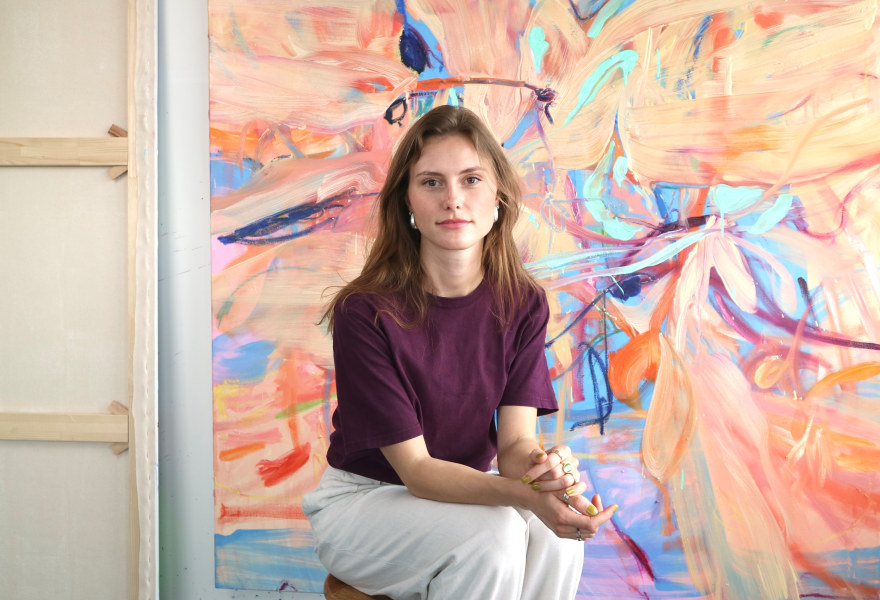06 may 2024, Wouter van den Eijkel
The studio of... Sofie van Thiel
Our Shared Breath is the first solo exhibition by Sofie van Thiel. In her colour and movement-filled abstract creations, she translates experiences and emotions onto the canvas. She starts with images that appear right before falling asleep, before the subconscious takes over. These images are highly abstract, with a swirl of colour, texture and composition. Once the first paint is on the canvas, she releases the image and every action becomes a reaction to the previous one. "Painting is a sort of dialogue between myself and the material, intuitively responding to how composition, colour and texture interact. Movement is important in this process, both as the language of the dialogue and because it's fleeting."
She borrowed the title of the exhibition from a book by American writer-scientist Robin Wall Kimmerer in which reciprocity is a central concept. Van Thiel describes it as a way of life in which you give and take, thereby maintaining balance. "The greatest compliment for me is when people feel the energy I put into my work. I consider wonder one of the essences of being human."
Our Shared Breath by Sofie van Thiel can be seen at Galerie Seine in Rotterdam until 26 May. Next week (9-12 May), Galerie Seine will be showcasing Van Thiel's work at Art on Paper Amsterdam.
Where is your studio and what does it look like?
My studio is located in a run-down office building in Rotterdam East. The entire area was built in the '90s, but is already slated for demolition due to a new zoning plan by the municipality. It's a shame, but it gives me the freedom to be as messy as I want. My studio is on the fifth floor in the corner of the building, has lots of light and views, so it feels like my own little tower.

Natural daylight from the studio, April 2024
I saw a picture of your studio on your Instagram profile, capturing the evening sun. Is natural light important to you as a painter?
Natural daylight is definitely important to me. Especially in the evening, I enjoy the sun setting behind the Rotterdam skyline, but I wouldn't want to limit myself to only daylight in my studio. Beautiful skies and a changing sun, especially its effect on the colourful world around us, inspire me daily, preferably when I'm out in nature. My studio is where I translate all those moments, different types of light and colours from outside, into paintings.
What does a typical day in your studio look like? Do you have routines, do you play music or prefer silence? Do you welcome visitors or prefer to keep the door closed to other people?
I love rituals. They give me peace, allowing me to better understand and embrace my creative process. I'm also a morning person; I love the fresh air and silence. By the time I'm fully awake, many people are still easing into their morning coffees. In the morning, I have a lot of energy, actually too much to paint, so I channel it into research. There's a lot of literature behind every painting.
Apart from painting, reading is my great obsession. I read about artists whose work I enjoy, such as Hilma af Klint, Vivian Suter, Agnes Martin and Georgia O'Keeffe. I read about colours, painting techniques and art history. I have an insatiable curiosity about the world around me and how other people and cultures perceive the world. All of this is reflected in what I paint. At around 11 a.m., I bike to my studio. However chaotic or emotional my thoughts may be, as soon as I enter my studio, I step into my own safe world. I consider my studio the inside of my head, only in physical form. I feel comfortable amidst my organised chaos, my paintings standing as protectors around me, forming the main characters in my own fairy tale. I like to invite people over, but I have to mentally prepare myself each time; inviting someone into the depths of your mind makes you vulnerable.
When I arrive at my studio, I take it easy. I always need time to adjust, but I've also learned that 'having to paint' works counterproductively. It's usually when I'm idly messing around or scrolling through Instagram (not a good thing, I know) without putting any pressure on myself, that I always find the right starting point. Having more confidence in that process feels liberating. When I'm painting, I like to listen to instrumental, psychedelic or (indie) jazz music, preferably with not too many vocals because they distract me.

‘Our Shared Breath’ in Studio Seine, on show until 26 May
Congratulations on Our Shared Breath, your first solo exhibition in a gallery! The opening just took place. Did it go as you had imagined? What was the best compliment you received?
Thank you! The opening of my first solo exhibition was fun and overwhelming at the same time. I got a lot of flowers and felt extremely grateful for the support and love from the people around me. The best compliment for me is when people feel the energy I put into my work. I consider wonder one of the essences of being human. We observe, we marvel and we share our experiences. If my translation of wonder into a painting resonates with people and they take a piece of it home with them, that's the greatest compliment I can receive.
The show takes its name from a quote by American writer Robin Wall Kimmerer. I'm not sure if she is well known to the general public, so can you tell a bit about who she is and what attracts you to her worldview?
Robin Wall Kimmerer is a writer, scientist, university professor and member of the Potawatomi tribe. In her partly autobiographical books, she intertwines Western science with knowledge from her indigenous tribe in a beautifully poetic way. A significant topic in her book Braiding Sweetgrass is reciprocity. It's a way of life in which you give and take, thus maintaining balance. I admire this worldview as a counter-movement to our capitalism-dominated world in which we seem to completely lose the knowledge and connection with nature (and with ourselves). As an artist, I am deeply concerned about what I leave behind and my paintings are my way of giving back after experiencing all the beauty I'm privileged to encounter.
In your work, you translate experiences and emotions onto the canvas. The works have titles like Sensory Pleasure and The Voice of the Rain. Also, your canvases are full of movement, so I can imagine that you partly lose control over the composition. How do you deal with this and what inspired this approach?
At the Willem de Kooning Academy, I studied illustration. It felt like I was constantly trying to colour within the lines, but failing every time. During my exchange in Sydney, I ended up at a traditional art academy where I took a painting course. An assignment was to adopt the technique of a famous artist for a few weeks. I chose Helen Frankenthaler's 'soak & stain' technique. The freedom it gave me was amazing. I experimented with pieces of unprimed canvas, threw paint on them and let them soak in the garden of the academy to see how the weather changed the canvas. That's where my affinity for starting something and then letting go of control came from. Although I no longer work with large blotches of acrylic paint, I approach painting in the same way. It starts with an image in my head, often something that comes to mind right before falling asleep, the moment when your brain moves towards theta waves, right before the subconscious where you're most creative. The visualisation is very abstract, with a swirl of colour, texture and composition. That's where I start, but once the first paint is on the canvas, I let go of that image. Every action is a reaction to the previous one. Painting is a sort of dialogue between myself and the material, intuitively responding to how composition, colour and texture interact. Movement is important in this process, both as the language of the dialogue and because it's fleeting. When a painting is finished, I don't see it as an object, but as a moment in time.

Sofie van Thiel, Bravado, 2023
What was the most challenging canvas to paint for Our Shared Breath?
The most challenging canvas for Our Shared Breath was also a revelation. Beneath what is now the painting, there was considerable experimentation. I think I started about two years ago with a idea, but I couldn't get onto canvas what I visualised in my head, so I banished it to a corner of my studio. One evening, I brought it out again and I finally managed to create what I had been envisioning all along. Thick layers of oil paint with lots of texture, but still transparent enough for colours from an underlayer to flow through. That same evening, it was finished. That transformation gave me such an adrenaline kick that the canvas got the title Bravado.
You graduated from the academy two years ago and already have your first solo show. What are your plans for the next five or so years?
I'm really a dreamer and secretly believe in manifestation, but at the same time, I have a pragmatic view of my future. Together with Linda Seine (Studio Seine), I'm mapping out my future path and making careful choices. Firstly, I want to gain as much exhibition experience as possible. Exhibiting my work in duo exhibitions with experienced artists, for example, is on my wish list. Dreams and goals for the coming years include residencies abroad because the idea of combining traveling, painting and personal development sounds fantastic to me. For the more distant future, I'm thinking of international projects and museum exhibitions. But for now, I'm focusing on my development as an artist and painting every day.

Aan het werk in het atelier, april 2024
This month, you'll be featured at Art on Paper. What can we expect?
I was drawing long before I started painting, but I never took my drawings seriously. It wasn't until Linda Seine (Studio Seine) visited my studio, noticed the drawings all over the walls and floor and explained their value to me that I started looking at them differently. We decided to showcase my drawings at Art on Paper Amsterdam. I draw partly to try out compositions and colours, partly as a playful extension of painting. Studio Seine will be presenting my drawings alongside work by Marisa Rappard and Esmee Seebregts, which fulfils a dream. The drawings we'll bring to Art on Paper are independent, but you can find elements in them that are also present in the paintings and vice versa.

'The Faraway Nearby V', on show at Art on Paper Amsterdam, Studio Seine, 9 - 12 May
What are you currently working on?
There are always several paintings in my studio that I'm working on right now. I've just returned from three months of traveling through Central and South America, where I sorely missed painting. Whenever possible, I'm in my studio and besides, I have a lot of experiences to process in my paintings. I'm also very busy preparing for Art on Paper Amsterdam, selecting drawings, framing works and brainstorming about the layout of our booth. I'm really looking forward to gaining experience at the fair and meeting people who are interested in my work at the Westergas in Amsterdam, where I'll be from 9-12 May.
